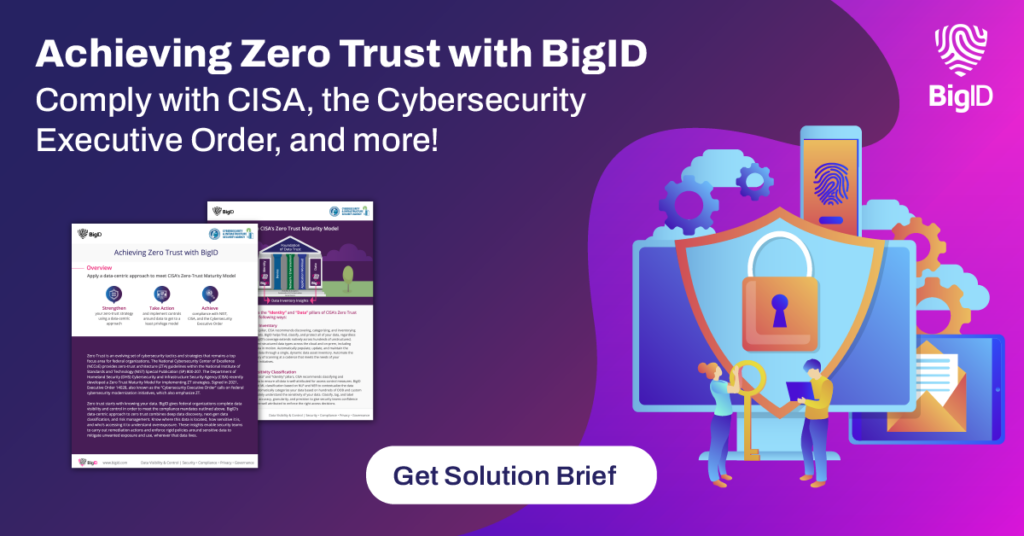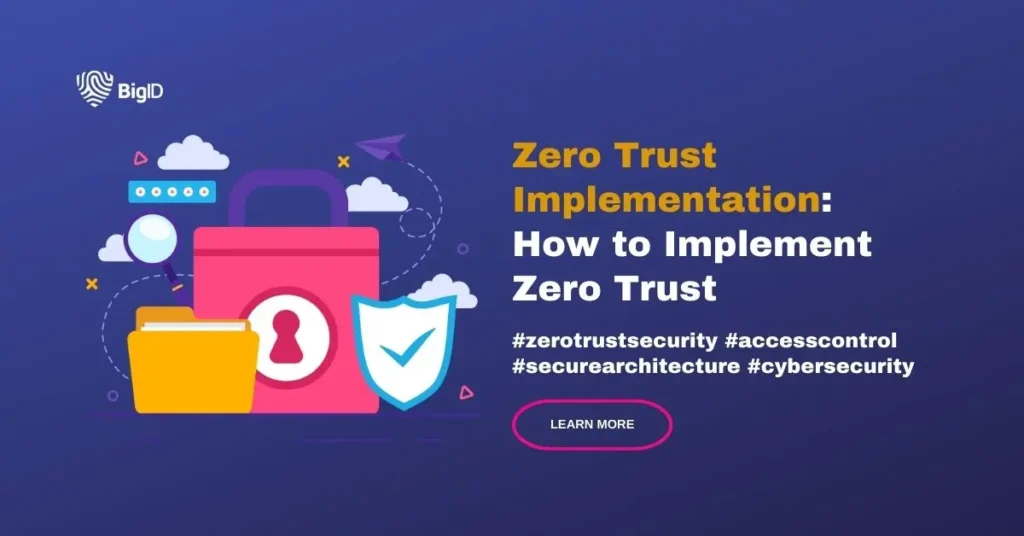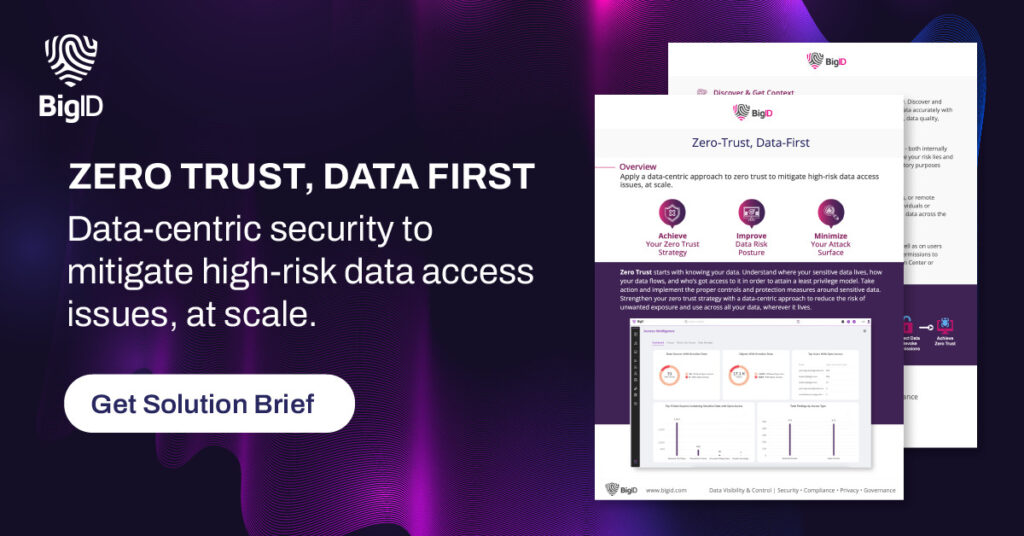Zero Trust Implementation: Never Trust, Always Verify
The threats that businesses face have evolved with technology over the years. Cyberattacks and data breaches have become more sophisticated, so organizations have had to change their security strategies.
Zero trust implementation is one way of securing your organization’s systems, network, and data.
In this guide to Zero Trust, we will discuss the approach and its core principles. We’ll also look at its benefits and challenges, and provide a step-by-step guide for its successful deployment.
Core Principles and Pillars of the Zero Trust Model
Zero Trust policies are built on certain core ideas and processes:
- Least Privilege Access: Users and devices are granted only the minimum level of access required to perform their tasks. This reduces the attack surface and limits potential damage in case of a breach.
- Micro-Segmentation: The network is divided into smaller segments to prevent lateral movement by attackers. This ensures that even if one segment is compromised, the rest of the network remains secure.
- Continuous Monitoring and Verification: Zero Trust emphasizes real-time monitoring of user and device behavior. Suspicious activities are flagged for immediate action.
- Strict Access Control: Access is controlled based on various factors, including user identity, device health, and location. Contextual information is used to make access decisions.
- Encryption: Data is encrypted both at rest and in transit, adding an extra layer of protection against unauthorized access.
What Does Zero Trust Architecture Implementation Mean?
In the past, a business’s data resided within its premises. That meant traditional security frameworks like VPNs, firewalls, and Data Loss Prevention (DLP) were enough to protect network boundaries. Like a fortress, the idea was to keep threats out, because everyone inside the perimeter was assumed to be trustworthy.
That’s no longer the case now. Business data is spread across cloud storage, SaaS applications, and external databases. Plus, there’s growing awareness about insider threats. There’s also the issue of the endpoints. With remote working, people are using their personal laptops and mobile devices. Relying only on perimeter defense also means that once someone gets inside the network, they can access anything within.
Zero Trust Architecture is a response to the dynamic nature of modern threats. It’s also been formally defined by the National Institute of Standards and Technology (NIST) in its Zero Trust framework (SP 800-207), which provides guidance for organizations adopting this model.
The Zero Trust cybersecurity framework assumes that potential risks can emerge from both outside and within the organization. Implementing it means putting this principle into practice across your entire IT environment. Instead of considering users or devices inside the network trustworthy, the model enforces the idea of “never trust, always verify.” That means every user, device, and application must be continuously authenticated, authorized, and validated before being granted access.
In practice, implementing Zero Trust involves several layers:
- Identity and Access Management (IAM): Strong authentication, least privilege access, and continuous verification of user identities.
- Device Security: Assessing and monitoring device health and compliance before allowing connections.
- Network Segmentation: Limiting lateral movement by breaking networks into smaller, controlled zones.
- Application and Workload Security: Protecting apps and workloads with policies that follow them across environments.
- Data Protection: Classifying and encrypting sensitive information to ensure it’s only accessible to authorized users.
- Visibility and Monitoring: Using analytics and automation to detect anomalies and enforce policies in real time.
Zero Trust Network Access (ZTNA)
Zero Trust Network Access (ZTNA) plays a central role in this process. ZTNA applies the Zero Trust model to network connections, enforcing authentication and authorization before granting access to specific applications or resources. This is especially critical in remote and hybrid work environments, where traditional network perimeters no longer apply.
By approaching implementation holistically—across identities, devices, networks, applications, and data—organizations can build a layered defense that reduces risk, limits the impact of breaches, and strengthens compliance.
Zero Trust Application Access (ZTAA)
Zero Trust Application Access (ZTAA) is another key part of modern cybersecurity. It focuses on securing access to applications for both users and devices.
ZTAA uses strong access controls and continuous monitoring to ensure that only authorized individuals can interact with critical applications and data. In this way, it acts as a reliable defense against unauthorized access, preventing breaches and quickly identifying emerging security vulnerabilities.
Zero Trust Access
Zero Trust Access combines the principles of ZTNA and ZTAA into a comprehensive framework that redefines modern network security. It ensures access is granted based on the specific context of each interaction, with continuous verification at its core.
By constantly checking the user’s identity, device health, and other relevant factors, Zero Trust Access creates a strong defense against data breaches. Its layered validation protects against unauthorized access while supporting secure and efficient collaboration.
Benefits of Implementing the Zero Trust Security Architecture
The adoption of Zero Trust helps organizations with several key security aspects:
- Enhanced Security: Because it assumes that threats can originate from within and outside the network, Zero Trust addresses all possible attack vectors and reduces the risk of successful cyberattacks.
- Minimize Attack Surface: The principle of least privilege and micro-segmentation reduce the potential attack surface, making it harder for attackers to move laterally within the network.
- Improved Compliance: Zero Trust aligns with many regulatory requirements, ensuring that organizations maintain a high level of data protection and privacy.
- Adaptability to Modern Work Environments: With remote workers and cloud computing becoming increasingly popular, Zero Trust enables secure access from anywhere, on any device.
- Real-time Threat Detection: Continuous monitoring and identity check mechanisms help identify and mitigate threats in real time, reducing the time to detect and respond to incidents.

Challenges of Implementing the Zero Trust Security Framework
While Zero Trust does provide better security, implementing it can be challenging. Here’s what you must address when implementing this framework:
- Complexity: Implementing Zero Trust is complex. To implement it, your organization must first understand its digital ecosystem. This involves detailed configuration processes that demand both technical expertise and strategic planning.
- Legacy Systems in Transition: If your business works on older systems, transitioning to Zero Trust requires balancing the functionality of these systems while adapting to modern security needs.
- Cultural Shift: Adopting Zero Trust isn’t just a technical change; it requires a shift in your organization’s mindset. This transformation involves changing how security is perceived and requires thorough education across all levels of the company.
- User-Centric Controls: Balancing strong security measures with a seamless user experience is challenging. You need to implement security controls that protect assets without hindering user convenience.
7 Steps for Implementing Zero Trust
Correctly implementing the Zero Trust approach fortifies your organization’s security posture. Here’s how to go about it:
- Assessment and Comprehensive Blueprinting: Thoroughly evaluate the existing security infrastructure to identify its strengths, fissures, and latent potential for enhancement. With this information, you can start planning and drafting a strategy to integrate Zero Trust principles into the overarching business objectives. This blueprint lays the groundwork for subsequent metamorphoses.
- Identity and Access: Zero Trust relies heavily on Identity and Access Management (IAM), where traditional user authentication and authorization evolve. Strong Multi-Factor Authentication (MFA) and Role-Based Access Control (RBAC) act as gatekeepers. They insist on thorough identity and permissions checks before a user can gain access.
- Segmentation: Divide your digital landscape into secure zones. Micro-segmentation further refines this process for more granular protection. Segmentation applies not just to networks, but also to workloads and applications. For example, isolating a virtual machine running sensitive processes from other workloads ensures that critical assets remain protected even if one environment is compromised.
- Constant Vigilance through Real-Time Surveillance: Implement continuous Monitoring tools that constantly analyze behavior in real time to detect even the smallest anomalies and trigger alerts, so you can quickly address any potential breach.
- Encrypting Data: Encryption protects your most valuable asset – your data. Whether stored or in transit, encryption hides the information behind an encoded layer to prevent unauthorized access.
- ZTNA and ZTAA: The final step involves deploying ZTNA and ZTAA. These tools manage user-device interactions by ensuring thorough confirmation of identity before granting access.
- Education: Success relies on empowering your people. Effective training helps users clearly understand Zero Trust principles and the importance of following security protocols.
Best Practices for Zero Trust Implementation
For simple and successful implementation of a Zero Trust security model, here are the best practices you need to follow:
- Verify User through Multi-factor Authentication (MFA): A simple password is no longer sufficient to securely establish a user’s identity. Traditional user credentials are no longer sufficiently reliable. Passwords are vulnerable. They are susceptible to phishing and malware interception. There’s a thriving Dark Web market for them. This is why it’s necessary to adopt Multi-factor Authentication (MFA). MFA supplements the conventional “something you know” (password) with the inviolable layers of “something you have” or “something you are.”
- Restrict Access Privileges: High-level user access privileges are an attractive target for attackers looking to steal valuable data. Therefore, managing admin privileges carefully is important. To reduce risk and strengthen security, limit access to only what is necessary for each role and enforce strict controls that uphold the principle of least privilege.
- Educate Users: Teaching employees and users about Zero Trust is like giving them a guidebook on how to keep things safe in the digital world. Educating members of your organization is a great way to reduce the instances of human error and insider risk.
How to Achieve Zero Trust with BigID
Start your Zero Trust journey with BigID’s industry-leading data security posture management (DSPM) platform. Using advanced AI and machine learning, BigID automatically and accurately scans, identifies, and classifies structured and unstructured data by context to give you better insight and control of your most sensitive data.
BigID’s Security Suite lets you proactively mitigate risk across your entire data landscape on-prem and in the cloud, with seamless integration amongst your existing tech stack. Revoke access from overprivileged users, conduct risk assessments, automate data discovery, and more—all under one comprehensive platform. Take a data-centric approach to cloud security and Zero Trust deployment with little time to value.
Learn more about DSPM and the part it plays in the larger Zero Trust strategy: DSPM Demystified



